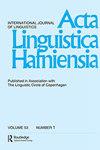Auxiliary choice with particle verbs of motion in Dutch
Q2 Arts and Humanities
引用次数: 2
Abstract
Abstract There is a long tradition of analyzing the use of the Dutch perfect auxiliaries hebben “have” and zijn “be” in semantic terms, which has centered around two notions: “change in the subject referent” and “telicity”. The present study argues that “change in the subject referent” is the most viable generalization, in light of attested examples with three particle verbs of motion: omdraaien “turn around”, weglopen “walk/run away” and afdalen “descend (off)”. While (telic) particle verbs are commonly said to take only zijn “be” as their perfect auxiliary, the three particle verbs studied here are shown to occur with hebben as well as zijn, in contexts that do not differ in terms of telicity. These data can be accounted for if the traditional notion of “change in the subject referent” is considered against the background of the cognitive-grammar notion of construal. In particular, the present study argues that zijn is used with these particle verbs when the motion event is construed as a (telic or atelic) change of state on the part of the subject referent, while hebben is used when it is construed as a subject’s executing or engaging in a (telic or atelic) type of act.荷兰语助动词的助动词选择
摘要荷兰语完成助动词hebben " have "和zijn " be "的语义分析由来已久,主要围绕"主语指称物的变化"和"目的性"两个概念展开。本研究认为,“主语指称物的变化”是最可行的概括,并通过三个运动助动词的实例证明:omdraaien“转身”,weglopen“走/跑开”和afdalen“下降(离开)”。而动词(表示目的的)粒子通常只需zijn说“是”作为他们的完美的辅助,这三个粒子动词研究显示与hebben以及zijn发生,在上下文不telicity方面的不同。如果将传统的“主语指称物的变化”概念放在解释的认知语法概念的背景下考虑,这些数据就可以得到解释。特别是,本研究认为,当运动事件被解释为主语指称物的状态变化时,zijn与这些助词动词连用,而hebben被解释为主语执行或参与(telic或atelic)类型的行为时,则使用。
本文章由计算机程序翻译,如有差异,请以英文原文为准。
求助全文
约1分钟内获得全文
求助全文
来源期刊

Acta Linguistica Hafniensia
Arts and Humanities-Language and Linguistics
CiteScore
0.90
自引率
0.00%
发文量
5
 求助内容:
求助内容: 应助结果提醒方式:
应助结果提醒方式:


